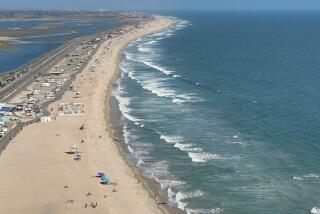Exploring the Lore of the Shore
- Share via
If life’s a beach, it now has a pair of biographers--college professors Lena Lencek and Gideon Bosker, dedicated beach-lovers from rainy, gloomy Portland, Ore., who have written a book called “The Beach: The History of Paradise on Earth” (Viking, 310 pages, $25.95).
Their sprightly narrative begins 4 billion years ago, when volcanic eruptions created the world’s oceans; takes us through the arrival of humans--when “the beach party could begin in earnest”--and, finally, shows us how we’ve mucked up our shores.
We’re served up dollops of biology, geology and anthropology as explanations of how the beach has influenced our thinking on sex, sports, fitness and fashion.
We explore the mythology of the sea. “Long before Steven Spielberg,” the authors note, the ancients saw the sea as “a damned world in whose darkness grotesque creatures cannibalistically devour each other and where the powers of hell rage unrestrained.”
We join a party of Roman noblemen as they frolic in the Mediterranean in 15 BC, their slaves following in boats, ready to row them back to their seaside pavilion to be oiled and perfumed as they sip their wine.
The British sought the seashore not for fun, naturally, but for their health and mainly in midwinter, subjecting themselves to ice-cold “therapeutic” plunges. We are taken to the Northeast coast of England in 1627: By the 17th century, we’re told, drinking “poisonous-tasting, foul-smelling, villainously tinted water was prescribed for a broad spectrum of disorders.” Many spas boasted bloodletting rooms or “phlebotoriums.”
Through the 18th century--when street fashions were decidedly body-concealing--the sexes bathed nude together. Horse-drawn “bathing machines”--wheeled cabins that towed bathers into the surf--offered optional “modesty hoods” to the reserved.
Bath, England, was the prototype for today’s beach resort. “The mixing of classes that went on at Bath was quite unprecedented in the history of England.” Brighton was big before losing its panache in the mid-1880s, when Queen Victoria declared it overrun with “flashy vulgarians,” prompting the upper crust to retreat to the new, elite beaches of France.
The authors note that it was the Romantics--19th century writers and philosophers--who taught the masses to love the sea. The poet Shelley, we’re reminded, “consummated a lifelong, almost pathological love affair with water by drowning, a volume of Sophocles in hand . . . in the Ligurian Sea.”
By the mid-19th century, “the psychosis-plagued Impressionists [had] elevated the seaside holiday to its sybaritic status.” Think Monet, Renoir.
On this side of the Atlantic, turn-of-the-century action was on the Jersey coast, which became “a burlesque for the masses.” At Atlantic City, beach fads included doing the polka in knee-deep surf.
The rich built marble-and-gilt seaside palaces at Newport, R.I., and Palm Beach, Fla., while the hoi polloi flocked to Coney Island’s beer gardens and sideshows--only a nickel subway ride from Manhattan.
Milestones in swimwear--a mini-industry spawned by the beach--have included Lastex rubber yarn (1931), the baring of male chests (1937) and the bikini (1946).
As for beach culture, 1964 marked “the dividing line between the era of the nuclear-family vacation to Miami Beach . . . and the commune on the beaches of Hawaii or Mazatlan” as children of the affluent “shed materialism, hypocrisy and clothing.” In 1966, the Mamas and the Papas sang “California Dreamin’,” and even young Iowans adopted the surfer look, complete with baggy Hawaiian-print trunks. Grown-up Mouseketeer Annette Funicello adorned those naive beach party movies.
In time, overdevelopment and pollution took a toll on the beach fantasy. But, “The Beach” suggests, the worst thing to happen to the beach lifestyle is the silicon microchip. Now beach-goers can take the office along. “At the turn of the 21st century,” Lencek and Bosker predict, “a beach vacation for the most affluent and successful . . . denotes a change of place, not of schedule.”
More to Read
Sign up for our Book Club newsletter
Get the latest news, events and more from the Los Angeles Times Book Club, and help us get L.A. reading and talking.
You may occasionally receive promotional content from the Los Angeles Times.








